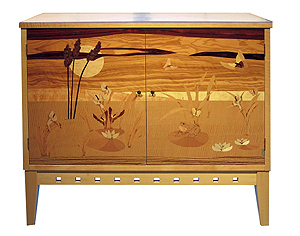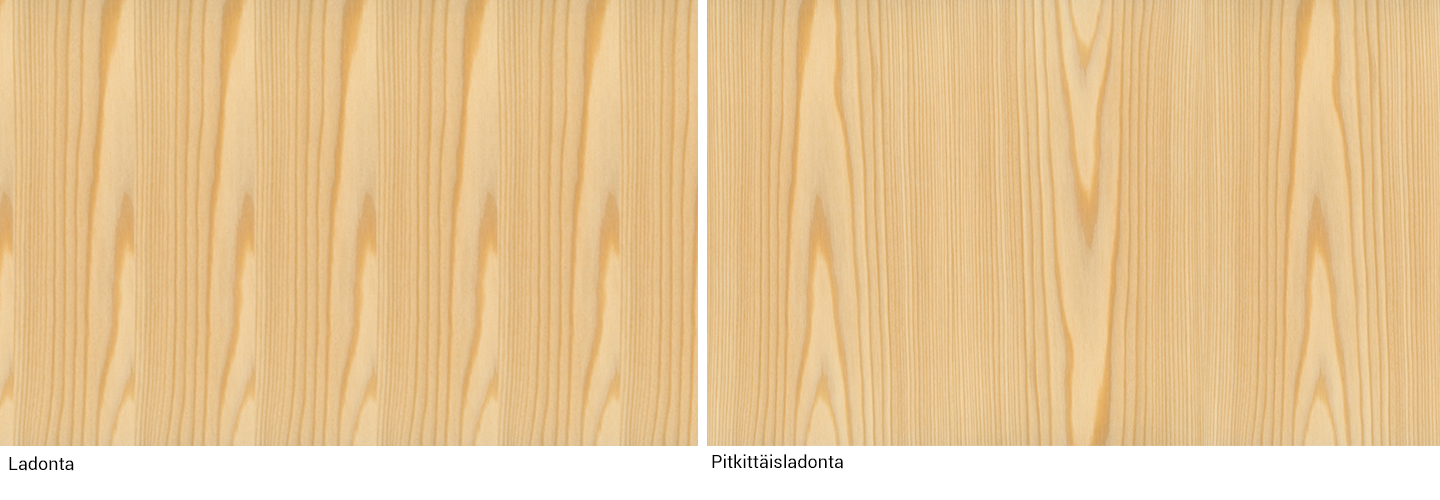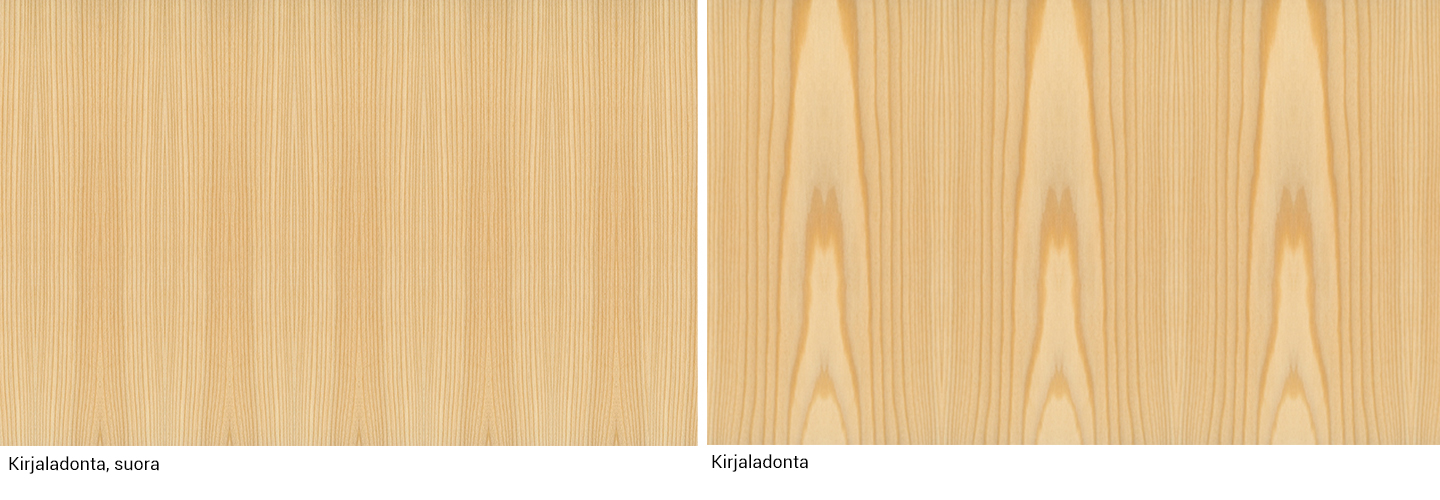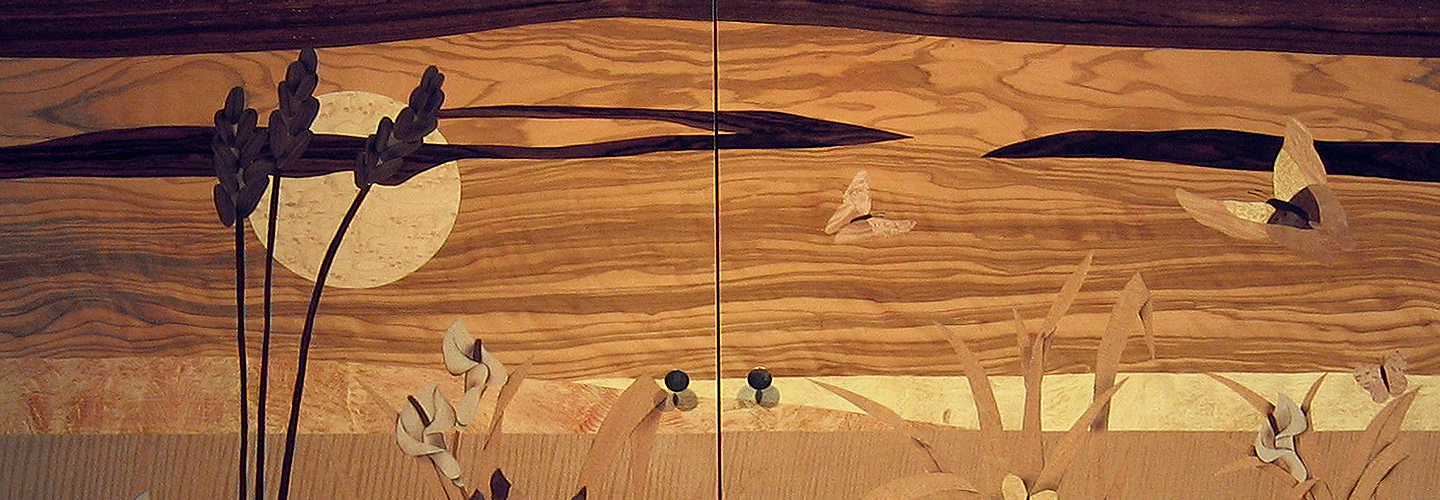The best quality and beautiful wood can be utilized on visible surfaces by veneering. Durable wood boards can be used for structures. One example is battenboard, for which poorer quality wood can be utilized. Professional design brings out the uniqueness, exceptional colours, and twisting patterns of wood fibres.

Veneer cannot be extended lengthwise. Veneer leaves can be glued together across lateral direction. In planning veneering, the measures of the board used as the base plate, and the width and the grain patterns of the surface of the veneer sheet have to be taken into account.
Generally veneer is 0,6 mm thick. 1,5 mm thick veneer is also available from several tree species. Even thicker veneers, up to about 4 mm, are available upon special order. The thicker the veneer, the more there is wearing surface for furniture.
Cutting and gluing veneer
Veneer leaves should be stored in a stock, where their moisture content will remain suitable for treatment and processing.
In the industry the edges of veneer leaves are cut straight. The jointing of separate veneers can also be done by lathing. The veneers are placed tightly next to each other, after which they are sewn together from their rear sides with a jointing machine. The glue thread melts when it is pressed on the base plate. With modern glues and machines it is also possible to glue veneer leaves with a butt joint without sewing. Jointing can also be done by taping. The way of gluing does not affect the quality of the surface of finished veneer.
In the industry the ready veneer sheets are pressed on glue surfaced board from both sides in a pressing machine with the help of heat (50-90 C°). For example battenboard, plywood, chipboard or MDF board is used as base plate. Boards made of massif wood always require cross-bonding as surfacing. In cross-bonding the thicker middle veneer prevents the wood from swelling and shrinking. Ordinary PVAc glue can be used in cold molding as well.
Boards must always be veneered from both sides (veneer – backing veneer) in order to prevent warping. Plain looking veneer or special paper can be used as backing veneer. Finished veneered boards are piled on top of each other in order for the cooling of the boards to be controlled. A protecting board is placed as a weight on top of the uppermost board.
After cooling the veneered boards are cut into their right size and the edges are battened. The battening can also be done before the veneering, in which case the battening is more tightly attached between the veneers.
Jigsaw has also been used to cut veneer. In addition, water cutting and laser cutting are new techniques in the industry.
Glues used in veneering
- Albumen-caseine glue is made from bovine blood. Caseine is milk protein which is, apart from glue, also used in the food industry and as a binding agent in putty and paints.
- Urea glues were used in the 1950s in the veneer and plywood industry. Urea resin glue (UF) contains formaldehyde.
- PVAc glue (PVAc) is dispersion-type glue, which is the most commonly used wood glue in the carpentry industry.
Placing veneers
The placing of veneers can be done in two main ways. The designer should choose the veneer patterns and define the arrangement in the design stage.
- Composition, which means that the veneers are placed side by side. This makes the grain pattern repeat itself similarly from leaf to leaf.

- Book matching, where every other veneer is placed as mirror image to the others.

Intarsia or inlay work
Intarsia usually refers to a visual whole made from veneers of different colours. The veneers are either attached so that they cover the surface or embedded in the background wood. Apart from wood, other materials, such as bone, mother-of-pearl and precious metals can be used for intarsia.
The so called window technique proceeds bit by bit: a piece is cut from the base veneer and a suitable part from another veneer is put inside the hole. Colour and grain pattern determine the suitability of the part. When all the replaceable pieces from the base veneer are substituted by new suitable pieces, the work is glued on its background.

Surface finishing veneer
The thickness of veneer, the production method and the way of arrangement affect the final result of the surface finishing. Thick veneers have more wearing surface and spare for polishing, but the cracks in the veneers are deeper. Glue used in the veneering process may penetrate thin (0,6 mm) veneers, which hinders surface finishing. The glue matter and the veneering temperature affect the fluidity of the glue. Therefore, it is important that every working phase is done carefully and with expertise.
Waxing, oiling and lacquering are the alternatives for surface finishing veneer. Different kinds of shadings and staining can emphasize the wood’s own tone or change it to another.
Terminology:
- veneer leaf = a separate veneer
- veneer bundle = 24 or 32 veneer leaves
- veneer log = veneer bundles from one tree form a veneer log
- veneer bale = 2000–4000 m2 veneer, usually a bale consists of several logs